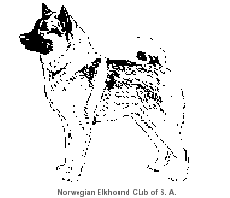Norwegian Elkhound
General Information - Norwegian Elkhound

Group:
Hound
Size:
large
Lifespan:
10-12 years
Exercise:
medium
Grooming:
medium
Trainability:
very low
Watchdog ability:
very high
Protection ability:
high
Area of Origin:
Norway
Date of Origin:
Ancient times
Other Names:
Elkhound, Norsk
Elghund
Original Function:
Hunting elk (moose)
History
The Norwegian Elkhound, known in its homeland as the Norsk Elghund, dates back to Antiquity, existing in Scandinavia for at least 5000 years as early as the time of the Vikings. The modern version was refined at the end of the 19th century. This hardy dog is very versatile, in that it hunts large game such as elk, wolves and lynx, retrieves small game such as rabbits, pulls sleds, and is used on the farm to herd small farmyard animals such as ducks and chicken. This active dog will require exercise on a daily basis.
Temperament
Enthusiastic and friendly the Norwegian Elkhound make an excellent family dog. Its independent nature sometimes makes it resistant to obedience training, and they may bark a lot. Norwegian Elkhounds make excellent guard and watchdogs. They are friendly and energetic and have very docile dispositions.
Upkeep
The Elkhound was developed to hunt all day under grueling conditions. It needs daily exertion in order to feel satisfied. This can be in the form of a good jog, very long walk or invigorating play session. It can live outdoors in temperate or cool climates, but it is happiest living with its family. Its double coat needs brushing twice a week and daily during main shedding season when it sheds a lot.
Norwegian Elkhound
A breed standard is the guideline which describes the ideal characteristics, temperament, and appearance of a breed and ensures that the breed is fit for function with soundness essential. Breeders and judges should at all times be careful to avoid obvious conditions and exaggerations, as well as being mindful of features which could be detrimental in any way to the health, welfare or soundness of this breed.
Breed Standard - Norwegian Elkhound
 Characteristics
Characteristics: The Norwegian Elkhound is a hardy sporting dog of Nordic type of a bold and virile nature, and has good scenting power. Its disposition should be friendly and intelligent, with great energy and independence of character, and without any sign of undue nervousness.
General Appearance: It has a compact and proportionately short body, a coat thick and abundant but not bristling, and prick cars; tail tightly curled over back.
Head and Skull: Broad between the ears; the forehead and back of the head are slightly arched with a clearly marked but not large stop. Muzzle moderately long, broader at the base and gradually tapering: whether seen from above or from the side - but not pointed; bridge of the nose straight, jaw strong with lips tightly closed.
Eyes: Not prominent, in colour brown and as dark as possible, giving a frank, fearless and friendly expression.
Ears: Set high, firm and upstanding, height slightly greater than their width at the base, pointed and very mobile.
Mouth: Jaw strong with lips tightly closed, teeth meeting in a scissor bite.
Neck: Of medium length, firm, muscular and well set up.
Forequarters: Legs firm, straight and powerful with good bone; elbows closely set on.
Body: Short in the couplings; back wide and straight from neck to stern; chest wide and deep with well:rounded ribs; loins muscular; stomach very little drawn up.
Hindquarters: Hind legs firm, strong and powerful, a little but definite bend at stifle and hock, and straight when viewed from behind.
Feet: Compact, oval in shape and not turned outwards; toes tightly closed; toe nails firm and strong.
Tail: Set high, tightly curled over the back but not carried on either side; hair thick and coarse.
Coat: Thick, abundant, coarse and weather:resisting; short on the head and on the front of the legs; longest on the chest, neck, buttocks, behind the forelegs and on the underside of the tail. It is composed of a longish and coarse top coat, dark at the tips with a light:coloured, soft and woolly undercoat. About the neck and front of the chest the longer coat forms a sort of ruff which, with the pricked ears, the energetic eyes and the curled tail, gives the animal its unique and alert appearance.
Colour: Grey, of various shades with black tips to the long outer coat; lighter on the chest, stomach, legs and the underside of the tail. Any distinctive variation from the grey colour is most undesirable and too dark or too light colourings should be avoided. Pronounced markings on legs and feet are also not desirable.
Gait: Demonstrates agility and endurance; stride at the trot even and effortless, back remaining level; as the speed of the trot increases, front and rear legs converge equally in straight lines towards a centre line beneath the body.
Weight and Size: For dogs, the ideal height at the shoulder should be 52 cm (20.5 in) and for bitches 49 cm (19.5 in). Weight approximately 23 kg (50 lb) and 20 kg (43 lb) respectively.
Note: Male animals should have two apparently normal testicles fully descended into the scrotum.
DNZ No 456
Copyright Dogs New Zealand
01 Jun 2003
Any departure from the foregoing points should be considered a fault and the seriousness with which the fault should be regarded should be in exact proportion to its degree and its effect upon the health and welfare of the dog and on the dog’s ability to perform its traditional work.




